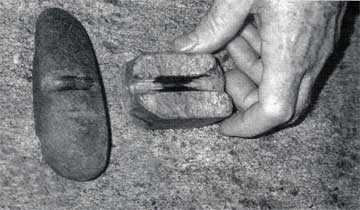
The use of heat for manipulating the shape of wood is a fundamental Stone Age woodworking technique. Heat is and was used initially to straighten spear and arrow shafts and also for periodic maintenance of straightness.
Typically, the shaft material is gathered in the green state, straightened with heat while still green and then tied into a bundle to dry. Some shaft materials will check if they are dried too quickly. To prevent this put wax or pitch on the ends and don't peel the bark until the shafts are dry. Patience! The contemporary primitive technologist can speed up the drying process by placing the bundle of shafts in the interior of a car in summer time.
One can apply heat to the shaft in several ways. For taking out long curves you can apply the heat of a small fire. For removing kinks you need a heat source which is concentrated in a small region of the shaft. The best way to do that is to use a piece of soapstone (steatite) with a semicircular groove. Heat the soapstone until it will fry spit (same criterion used by grandma for the pancake griddle). Use a pair of tongs to remove the straightener from the fire and place it on a slightly raised platform.

Place the part of the shaft to be straightened in the groove and rotate it. Rotating the shaft accomplishes two tasks. It applies the heat to the entire circumference of the region being straightened and it gives you a "feel" for where the high spot is. When the wood is hot then push down on both sides of the shaft to remove the bend. If you have never done this before then practice with something you don't care about. It's done by feel. This technique is especially valuable for bamboo, river cane, and phragmites which tend to collapse or buckle when bent with too much vigor. Another thing to do with shaft material which tend to buckle is to apply tension. Pulling on the ends of the shaft will reduce the tendency to buckle.
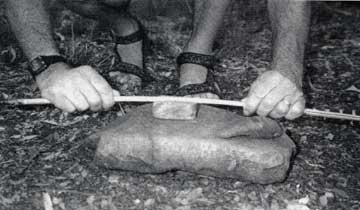
How hot is too hot? Ishi, a Native Californian and consummate craftsman who lived during the late nineteenth and early twentieth centuries, was disgusted with himself if he scorched an arrow shaft while straightening it. The wood should be heated hot enough to be uncomfortable to the touch but not hot enough to discolor.
Straightening the middle of a shaft is relatively easy because you have a "handle" on both sides but what about the ends of a shaft? Push down on the short end of the shaft with a small stick.
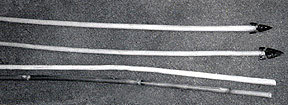

Soapstone is a superior material for arrow straighteners because it possesses three important properties. It doesn't crack or explode when heated, it is easily shaped and it is very soft and smooth so it won't scratch the wooden shaft being straightened. If you don't have soapstone then try the local materials. The first test you should do, even before you cut a groove in the stone, is to see if the stone retains its structural integrity while being heated.
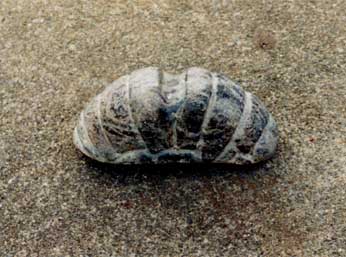
I also use heat to straighten a lot of spindles for starting hand drill fires. The materials I use, in order of preference are mare's tail (Conyza canadensis), mule fat (Baccharus virrinea) and elderberry (Sambuca spp). Several skeptics have asked me, "If you use heat from a fire to straighten the spindle you use to start a hand-drill fire, isn't that cheating?"
Yes, it is cheating but there is a way around it. One can heat straighten hand-drill spindles by using the heat of friction. Lay the crooked spindle on a log or flat surface with the convex side up. Then take a piece of dry, low density wood (like a hearthboard) and rub vigorously back and forth on the part which needs straightening.
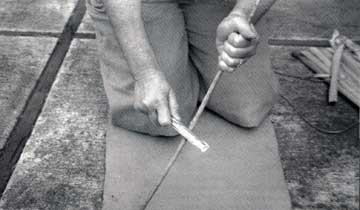
Another tool which is useful in heat straightening is the so called "arrow wrench". The arrow wrench is a 1ever about 10 inches (25 cm) long with a hole in one end. The wrench allows you to apply leverage to a small portion of the shaft. It can be made of wood or antler. The sides of the hole should be rounded in order to prevent denting the side of the shaft being straightened.

This article was first published in The
Bulletin of Primitive Technology (Fall, 2001, #22)
E-mail your comments to "Richard A. Baugh" at richardbaugh@att.net
We hope the information on the PrimitiveWays website is both instructional and enjoyable. Understand that no warranty or guarantee is included. We expect adults to act responsibly and children to be supervised by a responsible adult. If you use the information on this site to create your own projects or if you try techniques described on PrimitiveWays, behave in accordance with applicable laws, and think about the sustainability of natural resources. Using tools or techniques described on PrimitiveWays can be dangerous with exposure to heavy, sharp or pointed objects, fire, stone tools and hazards present in outdoor settings. Without proper care and caution, or if done incorrectly, there is a risk of property damage, personal injury or even death. So, be advised: Anyone using any information provided on the PrimitiveWays website assumes responsibility for using proper care and caution to protect property, the life, health and safety of himself or herself and all others. He or she expressly assumes all risk of harm or damage to all persons or property proximately caused by the use of this information.
© PrimitiveWays 2017